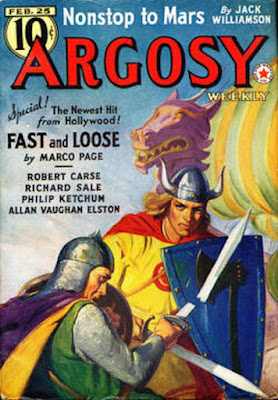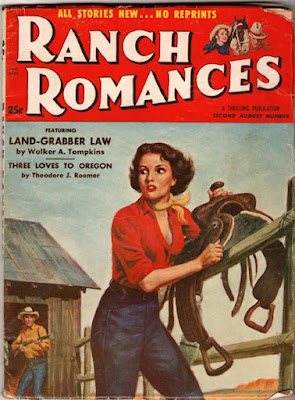This is a pulp I own and read recently. That’s my copy in the scan. FANTASTIC ADVENTURES was an odd mix of different kinds of fantasy stories with a science fiction yarn sneaking in occasionally. At this point in its run, it was edited by Howard Browne, a good editor and an excellent author in his own right. The cover of this issue is by an artist I associate more with science fiction, Ed Valigursky. He did a lot of covers for the Ace Double science fiction line, I believe.
One thing the Ziff-Davis pulps did that was different from other pulp
publishers was to put the word count of each story on the Table of Contents.
Those counts probably weren’t completely accurate, but they still give a good
approximation of each story’s length. The lead novel in this issue, “Rest In
Agony”, comes in at 32,000 words. That’s long enough to call it a novel, as far
as I’m concerned. The author, Ivar Jorgensen, was actually Paul W. Fairman in
this case. Fairman was a regular in the Ziff-Davis stable, both as a writer and
an editor. He doesn’t have a very high reputation in either role, but I’ve
always found his work to be enjoyable for the most part. The narrator of “Rest
In Agony” is clean-cut young college student Hal Brent. Hal’s Uncle Ambrose
dies, but then, after the funeral, Hal gets a phone call from him, begging for
help. It seems that Ambrose was involved with a Satanic cult and wrote a book
about their activities, and now the members of the cult will do anything to get
their hands on that volume, including menacing the lives of Hal and his
beautiful teenage sister.
This is an odd story, at times leisurely paced and poetic, almost dream-like,
reminding me a little of A. Merritt. Then at other times it’s lurid and over
the top like a Weird Menace yarn. There’s some very good writing in it in
places, and in other places the prose is rather clumsy. I’ll say this for it,
though: it kept me turning the pages. This story is available in an e-book
edition as a stand-alone novel under Fairman’s real name, if you’re interested
in checking it out yourself and don’t have a copy of this pulp. I enjoyed it
while still being aware that it’s hardly a great story. Kind of like most of
Fairman’s work that I’ve read.
Geoff St. Reynard was really Robert W. Krepps, best remembered today, aside
from his science fiction, as the author of numerous movie novelizations and
several well-regarded novels about Africa. His story in this issue, under the
St. Reynard pseudonym, is a novelette called “Wrestlers Are Revolting!” Since
it was written and published in the Fifties, this story comes from a time when
most science fiction writers and readers still considered a centralized,
heavy-handed, oppressive government to be a bad thing, so the villains are the
political rulers of the Federated Americas. They’ve banned all professional
sports except wrestling, since that’s the one where it’s easiest to control the
outcome of the matches, and the government-sponsored wrestler known as The
Chimera is unbeatable, not only defeating every challenger with his signature
move, the Siberian Death Lock, but also killing them in the ring, which is
permitted in this era. As always happens in cases of political oppression, an
underground has developed, dedicated to overthrowing the Federated Americas,
and the movement’s leaders are all wrestlers, including the story’s protagonist
Johnny Bell, who wants to be a writer but is forced into wrestling by the
government.
Clearly, this is a pretty goofy concept for a story. But it’s so well-written
that Krepps makes it easy for the reader to suspend disbelief and just roll
with it. It’s very funny in places, too, especially if you’re a wrestling fan.
The names, the gimmicks, the way the matches are staged, all that stuff is very
familiar to anybody who ever watched much professional wrestling. The Chimera
is a classic heel, and Johnny Bell, who competes under the name Bellerophon the
Great, is pure babyface. In an accidental prediction, there’s even a
wrestler-turned-referee named Paul Bearer! The wrestling part is amusing, the
political background is prophetic (especially since the story is set in the
early 2020s), and Krepps’ talent elevates what should have been silliness into
a very entertaining yarn.
Paul W. Fairman returns under his own name with a short story called “The
Secret of Gallows Hill”, which features some nice illustrations by Virgil
Finlay. This is a ghost story—or is it?—with its roots stretching back to the
Revolutionary War. Fairman springs a pretty nice twist ending in this one,
making it one of the better things I’ve read by him.
I don’t know anything about Francis G. Rayer except that he was a fairly
prolific but almost completely forgotten British science fiction author. His
story in this issue, “When Greed Steps In”, is about a couple of miners
competing for a rare, valuable metal on a newly discovered planet. It’s a
pretty mild story and also has a twist ending which gives it a little more
punch than it might have had otherwise. But it’s hardly memorable.
The issue wraps up with the novelette “Satellite of Destruction” by Ziff-Davis
regular Berkely Livingston writing under the pseudonym Burt B. Liston. This is
an alien invasion yarn, but rather than the attackers coming to Earth in rocket
ships, they arrive in a mobile asteroid that they put into the planet’s orbit
as a second moon. This is a fairly intriguing idea, but Livingston doesn’t do
much with it, delivering instead a World War II commando yarn with SF
trappings. I made it to the end of this story, but just barely. It just didn’t
resonate with me.
FANTASTIC ADVENTURES doesn’t have a great reputation as a science
fiction/fantasy pulp, and this issue is a good example of why not. One really
good (but not great) story by Krepps, two pretty good stories by Fairman, and
the other two are readable but not much more. Still, I’ve found something to
like in every issue of FANTASTIC ADVENTURES I’ve read, so I’m sure I’ll be
picking up another one sometime in the future.










.jpg)



















